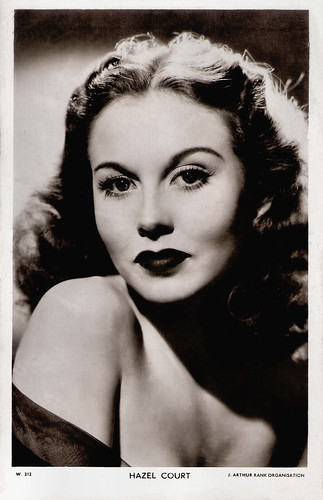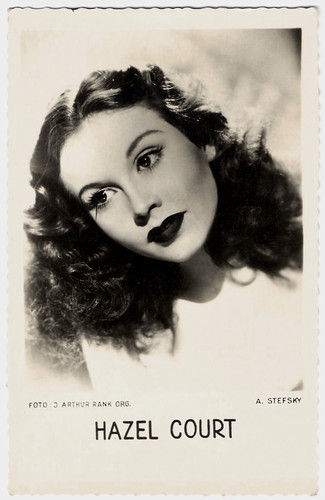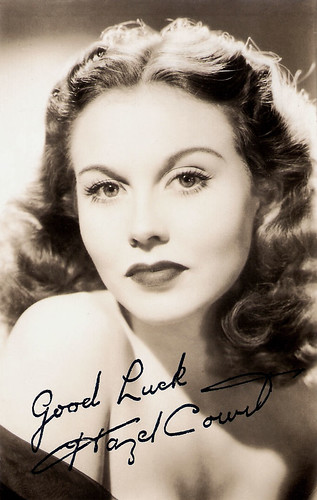
British postcard in the Picturegoer Series, London, no. W 312. Photo: J. Arthur Rank Organisation.
Pert and pretty
Hazel Court was born in Sutton Coldfield, Great Britain in 1926. She attended Boldmere School and Highclare College. Her father was G.W. Court, a professional cricketer.
At the age of fourteen, Hazel studied drama at the Birmingham Repertory Theatre and the Alexandra Theatre, also in Birmingham. Two years later, she met director Anthony Asquith in London during an air raid, which won her a bit part in the musical film Champagne Charlie (Alberto Cavalcanti, 1944), made by Ealing Studios.
Her only line of dialogue was "I never drank champagne before". The film was based on a play that depicted the real-life rivalry between 19th-century English music hall performer George Leybourne (Tommy Trinder), who first performed the song 'Champagne Charlie', and his colleague Alfred Vance (Stanley Holloway).
She got a contract with the Rank Organisation and trained at the studio’s ‘charm school’. Court won a British Critics Award for her supporting role as a crippled girl in Carnival (Stanley Haynes, 1946) about a ballet dancer of the Edwardian era, starring Sally Gray. Years later, Tom Vallance wrote in his obituary on Court in The Independent: “Pert and pretty, Hazel Court was a versatile actress who for several years was the epitome of the deceptively demure, often spunky, but very English heroine in British films of the Forties.”
She appeared in supporting parts in the comedy Holiday Camp (Ken Annakin, 1947) with Flora Robson, My Sister and I (Harold Huth, 1948) with Sally Ann Howes, and the drama Bond Street (Gordon Parry, 1948), starring Jean Kent. About the latter film, Hal Erickson writes at AllMovie: “This multistoried drama purports to detail the events occurring in a single 24-hour period on Bond Street, a 'typical' British thoroughfare. The Grand Hotel-like construction of the film allows for several colourful character vignettes.”

Vintage postcard. Photo: A. Stefsky / J. Arthur Rank Organisation.
An uptight, leather-clad female alien
In 1949 Hazel Court married Irish actor Dermot Walsh. They co-starred together in the fantasy film Ghost Ship (Vernon Sewell, 1952) as a young couple that acquires a yacht. The ship is haunted by the ghosts of a crew that had disappeared off the ship years before.
A cult classic became the Science Fiction film Devil Girl from Mars (David MacDonald, 1954). Patricia Laffan starred as Nyah, an uptight, leather-clad female alien, armed with a ray gun and accompanied by a menacing robot. She arrives at a Scottish inn to collect men as breeding stock, while Court plays a disillusioned fashion model who hides for a man who is following her.
In 1957 Court played the naive cousin-fiancee of Baron Victor Frankenstein (Peter Cushing) in The Curse of Frankenstein (Terence Fisher, 1957). It was the first colour Horror production by Hammer Film and the first of the studio’s Frankenstein series. Its worldwide success led to several sequels, and Hammer's new versions of Dracula (1958) and The Mummy (1959). Court's red hair and green eyes were seen in colour for the first time and her role plus her buxom gained her the status of a ‘scream queen’.
However, she wanted to act in comedy films, and in the 1957-1958 television season, she appeared in Dick and the Duchess, a CBS sitcom filmed in England. She played the role of Jane Starrett, a patrician Englishwoman married to an American insurance claims investigator living in London (Patrick O'Neal). Court travelled back and forth between Hollywood and England, appearing in four episodes of the TV series Alfred Hitchcock Presents (1958-1961). One of them showed her being transformed by her jealous husband (Laurence Harvey) into chicken feed.
In England, she played in Hammer Horror films like The Man Who Could Cheat Death (Terence Fisher, 1959) with Anton Diffring and Christopher Lee, and Doctor Blood's Coffin (Sidney J. Furie, 1961) with Kieron Moore. In the first, Diffring played a sculptor who had found a way of stopping the ageing process so that he was around 70 years older than he looked. While posing for him, Court actually bared her breasts, a scene cut from the British and American releases and only used for the foreign film market.

British postcard by Astra. Caption: "Lovely Hazel Court recently starred in Holiday Camp and My Sister and I."
A smouldering sensuality
By the early 1960s, Hazel Court had permanently moved to the United States. In Hollywood, she continued to appear in Horror films, now for American International Pictures. She knew how to project a smouldering sensuality in her roles, and it propelled her to a cult siren. Court was featured in three of AIP’s Edgar Allan Poe adaptations.
At the climax of the first one, The Premature Burial (Roger Corman, 1962), Ray Milland shovels dirt on her as she lies in a grave. In the black comedy The Raven (Roger Corman, 1963), she co-starred with Vincent Price, Peter Lorre, and Boris Karloff as a trio of rival sorcerers. The third and best was the exotic The Masque of the Red Death (Roger Corman, 1964). The blog Cult Sirens notes: “The Masque of the Red Death in 1964 is probably her most well-known role and surely her best performance. As Juliana, the bride of Prince Prospero (Vincent Price), her sex appeal is at its peak and her tragic death (a bit on the bloody side) is one of the film's highlights.”
Court's roles often relied on her cleavage and her ability to shriek in fear and die horrible deaths. It brought her fan mail, even in her later years. Court had divorced Dermot Walsh in 1963. They had a daughter, Sally Walsh, who at the age of four had appeared with her mother in The Curse of Frankenstein (1957). While shooting an episode of Alfred Hitchcock Presents, Court met American actor-director Don Taylor. They married in 1964, and Court retired from the film business to concentrate on being a wife and mother. They had a son, Jonathan, and a daughter, Courtney.
Through the years, Hazel Court guest starred in episodes of such classic TV series as The Third Man (1959), The Invisible Man (1959), Bonanza (1960), Danger Man (1960-1961), Rawhide (1964), The Twilight Zone (1964), and Twelve O’Clock High (1964-1965). After her marriage, she continued to do so and could be seen in Dr. Kildare (1965), Gidget (1966), The Wild Wild West (1966), Mission: Impossible (1967), Mannix (1968) and McMillan & Wife (1972).
Finally, she appeared briefly in the third Omen film, The Final Conflict (Graham Baker, 1981), starring Sam Neill and Rossano Brazzi. Like in her first film, she was uncredited in this Horror thriller and played a champagne-drinking guest at a party. In addition to acting, she was also a painter and sculptress and studied sculpting in Italy. Following her husband Don Taylor's death in 1998, she appeared on the cult movie conventions circuit. In 2008 Hazel Court died of a heart attack at her home near Lake Tahoe, California, aged 82. A week later, her autobiography 'Hazel Court - Horror Queen' was published by Tomahawk Press. One of Court's biggest fans is writer Stephen King who mentions her in various of his novels.
Trailer for Devil Girl from Mars (1954). Source: richmondfilmcorp2010 (YouTube).
Trailer for The Curse of Frankenstein (1957). Source: Rotten Tomatoes Classic Trailers (YouTube).
Trailer for The Masque of the Red Death (1964). Source: Pedro (YouTube).
Sources: Tom Vallance (The Independent), Ronald Bergan (The Guardian), Hal Erickson (AllMovie), Tom Weaver (IMDb), Horror Stars (now defunct), Cult Sirens, Wikipedia, and IMDb.
This post was last updated on 1 October 2023.
No comments:
Post a Comment